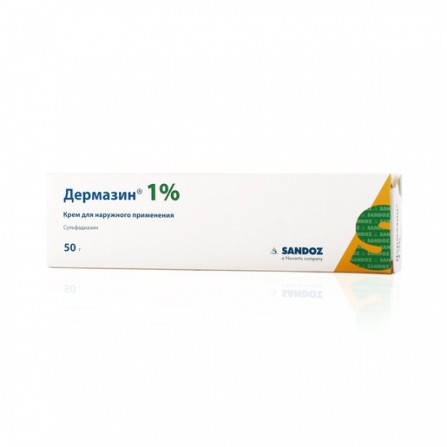Dermazine cream for external use 1% 50g
Condition: New product
1000 Items
Rating:
Be the first to write a review!

More info
Active ingredients
Sulfadiazine
Release form
Cream
Composition
1 g silver sulfadiazine 10 mg.
Pharmacological effect
Antimicrobial drug for external use, sulfonamide. When applied to the burn surface, silver sulfadiazine decomposes, slowly and continuously releasing silver ions and sulfanilamide ions, which inhibits the growth and reproduction of bacterial cells. Dermazine has a broad spectrum of antibacterial activity, including virtually all types of microbes that cause burns and other wounds on the skin surface (including Pseudomonas aeruginosa, Escherichia coli, Proteus spp., Staphylococcus spp., Streptococcus spp., Klebsiella spp. Enterobacter spp.), As well as yeast fungi (Candida albicans) and some strains of the herpes virus. Silver sulfadiazine penetrates necrotic tissue and exudate.
Indications
- treatment and prevention of burn infections (including before autodermoplasty). - treatment and prevention of infection of trophic ulcers, wounds.
Contraindications
- children's age up to 2 months - premature newborns - the period of childbirth - hypersensitivity to the drug components - hypersensitivity to sulfonamides.
Use during pregnancy and lactation
Dermazine should not be used during pregnancy, except in cases where the potential use of life-saving use exceeds the potential harm to the fetus. The use of sulfonamides increases the risk of hyperbilirubinemia, so you should not appoint Dermazine especially in the third trimester of pregnancy and during childbirth. The exceptions are cases where the potential benefit for saving the patient's life exceeds the existing risk to the fetus. It is not known whether silver sulfadiazine is excreted in human breast milk. However, other sulfonamides are found in milk. In addition, all sulfonamides increase the risk of hyperbilirubinemia. In connection with the possibility of serious side effects in an infant when sulfonamides are used in a nursing mother, if the drug needs to be used during lactation, it is necessary to decide whether to stop breastfeeding, taking into account the degree of significance of treatment for the mother.
Dosage and administration
Dermazine can be applied with or without dressings. The drug is intended only for application to the skin. After surgical treatment of the burn surface, the cream is applied on it in a layer of 2-4 mm thick. The drug should be applied 1-2 times / day. Treatment should continue until the wound surface is completely healed. The method of application and dose of the cream is the same for the treatment of burns and trophic ulcers. Dressings should be changed daily.
Side effects
Local reactions: rarely - burning sensation, itching. On the part of the hematopoietic system: in some cases, the development of transient leukopenia (mainly a decrease in the number of neutrophils) was noted in patients treated with silver sulfadiazine. The maximum decrease in the level of leukocytes is observed for 2-4 days after the start of treatment. Then their level is normalized within 2-3 days, while the continuation of silver sulfathiazine treatment does not affect the recovery of the number of leukocytes. There are separate reports on the development of skin necrosis, erythema multiforme, disorders of skin pigmentation, interstitial nephritis. The degree of absorption of silver sulfadiazine depends on the size of the burn surface and the degree of tissue damage. In rare cases, it is possible that any adverse reactions characteristic of sulfonamides may develop: hematopoietic disorders (including agranulocytosis, aplastic anemia, thrombocytopenia, leukopenia, hemolytic anemia), skin and allergic reactions (including Stevens-Johnson syndrome and exfoliative dermatitis), dyspeptic symptoms, dyspeptic symptoms, dyspeptic phenomena, hepatitis, exfoliative dermatitis, dyspeptic symptoms, dyspepsia, and hepatitis; hepatocellular necrosis, CNS reactions, toxic nephrosis.
special instructions
Local reactions: rarely - burning sensation, itching. On the part of the hematopoietic system: in some cases, the development of transient leukopenia (mainly a decrease in the number of neutrophils) was noted in patients treated with silver sulfadiazine. The maximum decrease in the level of leukocytes is observed for 2-4 days after the start of treatment. Then their level is normalized within 2-3 days, while the continuation of silver sulfathiazine treatment does not affect the recovery of the number of leukocytes. There are separate reports on the development of skin necrosis, erythema multiforme, disorders of skin pigmentation, interstitial nephritis.The degree of absorption of silver sulfadiazine depends on the size of the burn surface and the degree of tissue damage. In rare cases, it is possible that any adverse reactions characteristic of sulfonamides may develop: hematopoietic disorders (including agranulocytosis, aplastic anemia, thrombocytopenia, leukopenia, hemolytic anemia), skin and allergic reactions (including Stevens-Johnson syndrome and exfoliative dermatitis), dyspeptic symptoms, dyspeptic symptoms, dyspeptic phenomena, hepatitis, exfoliative dermatitis, dyspeptic symptoms, dyspepsia, and hepatitis; hepatocellular necrosis, CNS reactions, toxic nephrosis.




